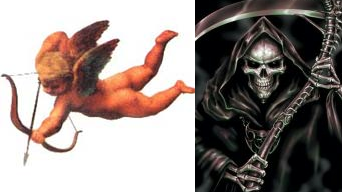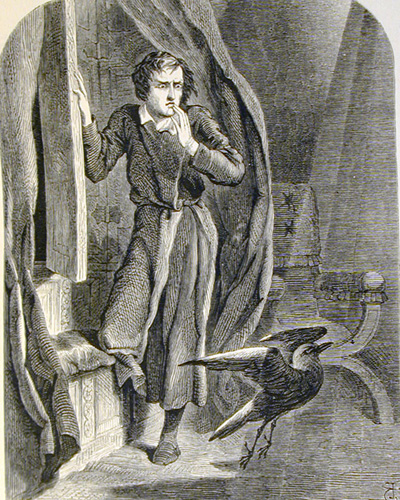
|

|
|

|

|

|

|

|
Death and love are the two themes that occur in most of Poe's poems,
and occur a lot in his life as well.

Love and death are symbols that are reoccurring in Poe's poems, and if you know anything
about Poe's life, its not hard to understand why. Poe dealt with death through all of his life whether it was the death of
his mother, brother, or wife, death was always haunting Poe. This is especially apparent in his poem "Alone". This poem definitely
brings out his feelings in life. Poe talks about how he has always been different. This poem has a very somber tone and rhythm.
The repeating words in the second and third lines really make the poem flow smoothly. "I have not been/as others were; I have
not seen/ as others saw". This is showing the opposites between him and all else, and the last line finally gives the reason
as to why he's so different. "(When the rest of heaven was blue)/ Of a demon in my view." This emphasizes how his childhood
affected him. He will always see death because it has always been in his life. In the poem "The Lake" Poe talks of how death
was in the lake's wave, and a solitary soul could make an Eden of that grave. He seems to be saying that a lonely soul could
be happier in death. This idea may have contributed to his attempted suicide months before his death. "To the One in Paradise"
is about how even though he tried to focus on things like love, he always went back to death. Love was a "dream too bright
to last!" (2). He could never stray away from death.
Many of Poe's poems involve the death of a beautiful woman.
Some of these poems include: "Annabel Lee" "The Sleeper", "Lenore", "Ulalume", and even "The Raven". "Lenore" is about a woman
that has died, seems like he is speaking at her funeral, Poe talks of how she still has life in her hair, but death in her
eyes (19-20). More than anything, this poem helped Poe come up with the idea for his most famous poem: "The Raven". He used
the name Lenore in "The Raven", and the word "nevermore" is the dominant word, which is found in the third line of the poem
"Lenore."; "Ulalume" is a brilliant poem. It is a poem that is filled with a lot of symbolism with his psyche and soul. It
is about the narrator on a walk talking with "Psyche." The narrator is mindlessly walking on a normal night, and at the end
he ends up near the tomb of his love Ulalume exactly one year before. This poem is beautifully written because of the flow.
Much of it due to Poe's repeating of lines. "On this very night of last year/ that I journeyed- journeyed down here-/ that
I brought a dread burden down here." (86-88) This poem also reminds me of his wife because no matter how hard he tries to
forget, he never will.
Death is a main theme in Poe's poems, but an even greater theme is love. Love
can be found in numerous poems. One is called "The Bridal Ballad" which is about a woman on her wedding day. Poe does what
he does in a lot of his poems; he repeats a phrase many times. In this poem he repeats "happy now" at the end of every paragraph
to get the feeling across that he wants. He starts happy with the woman being happy, but it ends with how her first love that
died may not be happy that she is re-marrying. The poem "Song" is a happy one; although, it's about his first love, Elmira,
marrying another man. 'Happiness around thee lay;/ The world all love around thee lay" (15-16). It talks about how happy and
in love she is. Love may be in a lot of poems because a lot of his poems were written for woman that he was trying to swoon.
When his wife died, he tried to get three different women to marry him. He wrote many poems for these women. Many entitled,
"To Helen", "For Annie" etc. They are all about the love of these women, and how beautiful they are.

Although many of Poe's poems are similar, they all lead up to his most famous one, "The Raven." (Picture illustrated
by John Tenniel)
|

|

|

